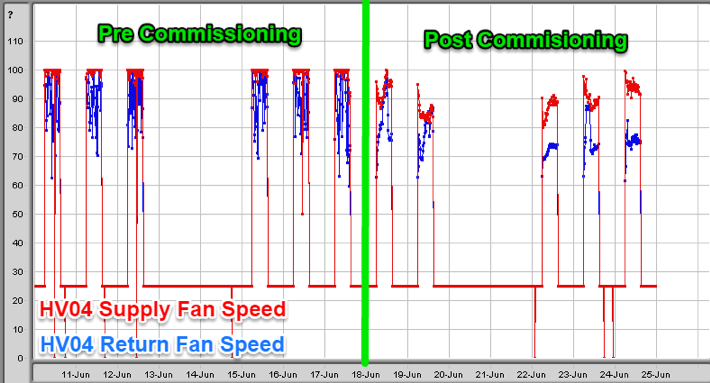The key step to building optimization is looking for the problems

Williams Lake, BC
With minor changes to building controls, Rede Energy Solutions reduced electricity consumption by 19% and gas consumption by 13% in a school in British Columbia in 2014.
How did we do it?
“People think energy savings is going to come from some crazy change or some crazy science,” says Marco Bieri, energy efficiency engineer for Rede.
“It’s not rocket science. It just takes somebody to actually go through and look at the data.”
This project in Williams Lake with School District #27 is still a highlight for Marco, who started at Rede in 2013. It wasn’t noteworthy for any innovative energy efficiency approaches or new technology. The thrill came from discovering significant improvements by “just finding errors.”
Marco reviewed the logs from the building automation system and then plotted and analyzed all the data.
“I just looked at trends and identified that schedules were broken on a lot of panels. Equipment was running more than is should,” explains Marco.
“Long-story short, the program was telling it turn off but it was not talking properly so everything was just on.”
Refining schedules, fixing errors and a few repairs to the equipment resulted in an annual savings of nearly $14,000. Here is a breakdown of the solutions in the first year:
| Equipment | Problem | Solution | Annual Savings |
|---|---|---|---|
| Multizone 5 HP supply fan | Schedule was overridden by BAS | Removed override | $2,014 |
| Multizone 5 HP supply fan | Not following schedule and improper cycling during operation | Fixed program bug | $1,192 |
| Band room 3 HP supply fan | Not following schedule | Fixed program bug | $1,029 |
| Gym 10 HP supply fan | Schedule was overridden by BAS | Removed override | $2,651 |
| Dual duct system | Simultaneous heating and cooling when scheduled to off | Fixed loose wires in controls and readjusted setpoints | $2,630 |
| VFD in 10 HP supply fan | No modulation due to broken sensor | Fixed power supply to sensor | $565 |
| Mixing damper | Not following schedule | Fixed program bug | $472 |
| VFD in 15 HP supply fan | No modulation due to broken sensor | Fixed power supply to sensor | $772 |
| BAS schedule | Not following summer schedule in July | Adjusted schedule in BAS | $1,703 |
| Main boiler circulation pumps | Always on during heating season | Fixed program bug | $887 |
| Gym boiler circulation pumps | One pump operating most of the time and not following summer boiler shutdown | Fixed program bug | $70 |
The changes are evident when the data is plotted. This is the supply fan from the band room before and after commissioning, where the fan was not following the assigned schedule due to a programming error:

And here is the VFD that was not modulating:

Energy Savings
19% electricity & 13% gas
How it was done
Data analysis of building automation logs
~80% of adjustments were to schedules and controls and ~20% of adjustments were to the systems
Costs and savings
Total project costs: $27,500
Savings in year one: $25,000
Reviewing the data has created opportunities for savings at many facilities that Marco has analyzed.
“A lot of time, we find stuff like schedules that don’t work for whatever reason. Or an occupancy sensor is screwed up so the fan is always on.”
The best part – analytics is a problem-solving tool that is available for every facilities manager.
Interested in saving energy in your facilities? The next step is simple. Just send us a message and we can begin searching for opportunities to save your organization energy and money.
